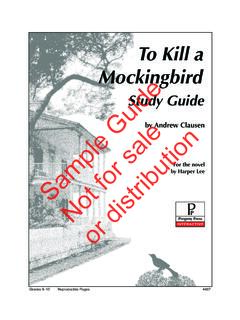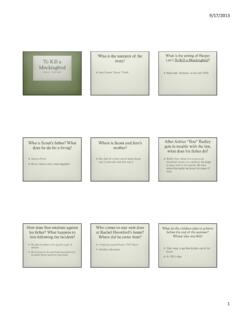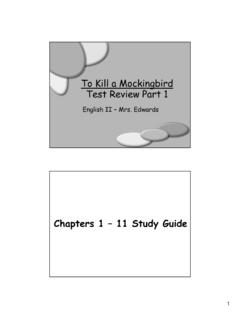Transcription of Motifs and Symbols in To Kill a Mockingbird - Hellesdon
1 Motifs and Symbols in To kill a Mockingbird COPYRIGHT NOTE: THIS STUDY GUIDE IS PRODUCED IN GOOD FAITH, AND IS BASED ON MATERIALS OF WHICH EITHER I AM THE ORIGINATOR, OR CAME TO ME UNMARKED WITH COPYRIGHT NOTIFICATION. HOWEVER, IF I HAVE UNCONSCIOUSLY QUOTED COPYRIGHTED MATERIAL WITHOUT ACKNOWLEDGEMENT, PLEASE CONTACT ME ON AND I WILL IMMEDIATELY AMEND THIS PDF. D. P. ARMSTRONG. Note: in the exam give the book its full title the first time you mention it, then call it Mockingbird . Underline the title rather than put inverted commas round it. Take a copy of the book into the exam making sure it has no notes in it and look for the Mockingbird question (you should have a choice of two) as soon as you open the exam paper. Make sure everything you write is in answer to the question it doesn t matter if you know Mockingbird off by heart if you don t answer the question you won t pass the paper. Motifs are recurring images (the pictures that words make in your head) in a work of literature.
2 They have metaphorical or symbolic value, often supporting a theme or important idea. Symbols are images which represent an idea, like the canary represents Norwich City , or a crown represents the Queen. The examiner knows what Motifs and Symbols are, so don t define them in your essay. 1. The Mockingbird A Mockingbird is the long tailed songbird Mimus polyglossus, related to the finch (you can make something of this) and native to the Southern States of America. It is quite a plain bird which gets its name from its habit of imitating other birds' songs sometimes up to thirty. It can be related in the book to three people: Tom Robinson, the " Mockingbird " that it is a sin to kill ; Boo Radley, who like the bird is a victim of children; and Scout, who is small and plain, but "sings" her own song the novel. Both Tom and Boo are victims of their own kindness (towards Mayella; towards the children); both are innocent (of rape; of psychopathy); both are victims of prejudice; both are "caged".
3 More subtly, the Mockingbird could represent the innocence of childhood which is "killed" in various ways for Scout, Jem and Dill. The Mockingbird first appears in Chapter 10, when Atticus tells the children, "Shoot all the bluejays you but remember it's a sin to kill a Mockingbird " (p99). Miss Maudie explains this is because mockingbirds are neither harmful nor destructive, but only make music for people to enjoy. Its connection with Boo and Tom is made clear in Chapter 30 (p304), where Scout recognizes that the public exposure of Boo would be "sort of like shootin' a Mockingbird ". 1 Other than the above instances the motif recurs on: p105, Chapter 10 after the killing of Tim Johnson; p232, Chapter 21 waiting for the trial verdict; p265, Chapter 25 in Underwood's article; p281, Chapter 21 on the way to the pageant. As in the last example, the Mockingbird is silent at times of tension; it is often mentioned in passages of descriptive beauty.
4 Other references to mocking: The children mock Boo and his life when they imitate and make fun of it; Mayella accuses Atticus of mocking her; The trial is a mockery of justice. The Mockingbird therefore links with the themes of Prejudice, Childhood, Imprisonment and Justice. We might also bear in mind the popular American lullaby about a Mockingbird : And if that Mockingbird don't sing Daddy's gonna buy you a diamond ring. If we follow this idea we might say that the Mockingbird contains the idea of what is passed down within a family, like a heirloom, or like the ideas Atticus passes on to Scout. Certainly the final image of the book is the strength of the father daughter relationship. As for the jay, these are the bullies of the bird world, which makes Bob Ewell one. 2. Flower Symbolism a) Camellias. According to York Notes, "Mrs Dubose's camellias represent the prejudices which cannot be brushed off easily.
5 They have to be tugged by their roots". Thus Jem's action in cutting otheir heads symbolizes his youthful rashness in thinking that prejudice can be dealt with so simply. I also think that snow-on-the-mountain (note the association of coldness and whiteness), a posh flower, represents Mrs Dubose's standing in the community - her status - while the single one Jem receives after her death is a symbol of reconciliation, one of the themes of the book which Jem has to read to Mrs Dubose - Sir Walter Scott=s Ivanhoe - as well as symbolizing her freedom from addiction. ff b) Azaleas. These are grown by Miss Maudie, who spends a lot of the novel gardening. A type of rhododendron, they are famous for growing in adverse conditions - shade and barren or acid soil - just as Miss Maudie always has a sunny character despite the bitterness and prejudice around her in Maycomb. Azaleas are also known for opening their flowers all at once - and before the Tom Robinson trial Miss Maudie has a verbal battle with the foot-washers (Puritans) who criticize her for having such showy flowers.
6 They might be said to symbolize her independence and love of beauty. 2 c) Geraniums. These are a cultivated relative of the wild cranesbill, tend to smell like cats, and would not be kept by either Miss Maudie or Mrs Dubose they are a poor person s substitute for roses. Mayella Ewell=s geraniums seem to be the only things growing in Bob Ewell s madhouse of a dwelling. Though they smell of cats they nevertheless symbolize Mayella=s cleanliness (p, 183) and unrequited (unfulfilled) love - the love that never comes her way, and which she tries to force from Tom Robinson. Poignantly, Mayella grows them in "six chipped enamel slop jars" chamberpots in the yard, presumably because they are the nearest to plantpots available to her. Geraniums grow in any soil providing it is not waterlogged so are easy to grow in dry Maycomb. 3. Tim Johnson The mad dog episode is usually taken, together with references to disease in the novel, to represent the racialism which is rampant in the South, and spreads like a contagion.
7 Atticus, by shooting Tim Johnson, sets himself up as the "hero" who will attempt to bring down racism. Note the parallel drawn with this episode by Scout when the jury gives its verdict (p217). I wrote the following notes for a class which had answered a question on Chapter 10 in a mock exam. To kill a Mockingbird : Symbolism in the Tim Johnson Passage There is a complex system of motif (recurring images) and symbolism throughout the book. The interpretation of symbolism is an important skill, one which tends to sort the sheep from the goats that is, the perceptive student from the unappreciative. When Harper Lee submitted her manuscript to the publishers it is known to have been little more than a collection of short stories; however, after two years collaborative revision by her editor, Tay Hohoff, it became the novel that we know. The first reaction, then, to the question about Harper Lee s symbolism might be to ask whether it was Lee or Hohoff who put it there which would impress the examiner that you had read round the subject.
8 Symbolism is like metaphor in the way that it represents a difficult, complicated or abstract idea through a commonplace object. When given a question like this, think about each object, living or not, and ask yourself what else it could possibly represent what does it remind you of elsewhere in the book or in life? So long as there is textual evidence to back up what you say, don t be afraid of being far fetched. For example, one of you said Atticus taking off his glasses reminded her of Clark Kent turning into Superman. This was a perfectly valid comment: even though Superman was invented slightly after the end of the novel (1938) it could well have been that such symbolism was on the author s mind. It might have 3 been taken further by saying that as the mockingbirds go silent during the shooting the Mockingbird s song being used throughout the novel as symbolic of reading, expression or communication this symbolizes Atticus leaving behind his reading in order to become a man of action just as Clark Kent leaves his reporter s desk to become the same.
9 Another of you said that Atticus removing his glasses was symbolic of his taking on another view or perspective an equally valid interpretation. The key to the passage s main symbolism can be found on page 217, when Judge Taylor gives his verdict on Tom Robinson, and Scout goes into a kind of dream world, where she sees something like watching Atticus walk into the street, raise a rifle to his shoulder and pull the trigger, but watching all the time knowing that the gun was empty . We can understand from this that Tim Johnson foreshadows is a prediction of something more abstract that had to be killed (though Atticus was unable to kill it) that is, the sick, mad, deep rooted prejudices of the American South. That Tim Johnson is coloured brown and white might also have tipped you off to the racial symbolism in the passage, and a number of you made the connection between the innocence of the dog and the innocence of Tom Robinson, who was also shot for being what he could not help but be.
10 One of you suggested that Tim Johnson represented ignorance and misunderstanding in general, specifically of Atticus himself by his children; another of you rather cleverly drew a parallel between the rapid decision of Heck Tate that the dog must die without even consulting with the owner and the rapid, thoughtless snap judgements which are typical of a prejudiced mind. Note that you could say that the dog s snail s pace could be a reference to the slow pace of change in Alabama, and the invisible force which moves it the invisible but pervasive secret court of men s hearts which silently dictates the law in Maycomb. Several of you read various meanings into Atticus s rifle, taking it to symbolize power, the control of power, or the little seen, darker side of Scout s saintly father. One student interpreted Miss Maudie s comment that Atticus put his gun down when he realized that God had given him an unfair advantage as referring to the unfair advantage that whites held over blacks (because of the colour of their skin) and how whites like hunters preyed on the defenceless blacks.
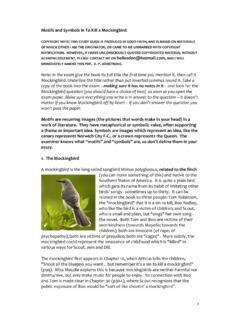
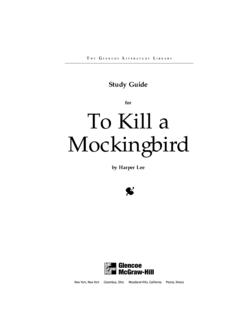
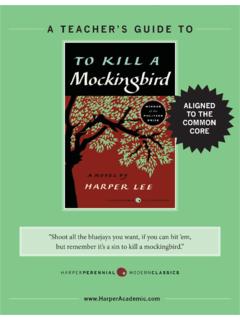
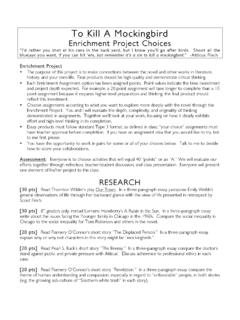
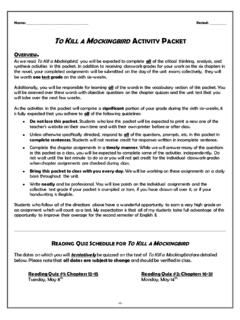
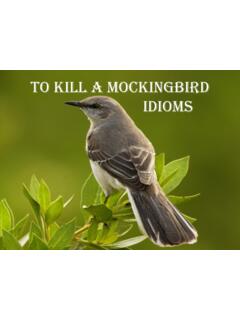
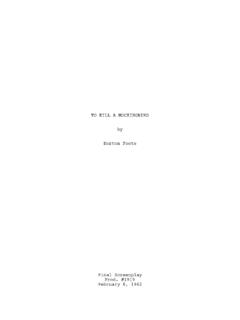
![To Kill a Mockingbird [cs] - Summer Reading 2017](/cache/preview/f/9/2/0/8/8/3/f/thumb-f920883fa32701234ba22060bbd111c1.jpg)
